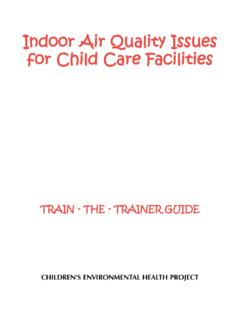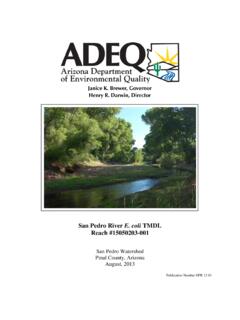Transcription of R18-9-E301. 4.01 General Permit: Sewage Collection Systems
1 R18-9-E301. General permit : Sewage Collection Systems A. A General permit allows a new Sewage Collection system or an expansion of an existing Sewage Collection system involving new construction. 1. A sewer Collection system includes all sewer lines and associated structures, devices, and appurtenances that: a. Are owned or controlled by a public or private sewer utility extending from the treatment works to the upstream points in the system where private owners assume ownership or control; or b. Serve multiple private users from the upstream points where the individual users assume ownership or control to the downstream point where the sewer delivers wastewater to a Sewage Collection system owned or controlled by a public or private sewer utility, or to a Sewage treatment facility. 2. A sewer Collection system repair is not an expansion of the system that requires a Notice of Intent to Discharge. Repairs include work performed in response to deterioration of existing structures, devices, and appurtenances with the intent to maintain or restore the system to its original operational characteristics.
2 B. Performance. An applicant shall design, construct, and operate a Sewage Collection system so that it: 1. Provides adequate wastewater flow capacity for the planned service;. 2. Minimizes sedimentation, blockage, and erosion through maintenance of proper flow velocities throughout the system ;. 3. Prevents sanitary sewer overflows through appropriate sizing, capacities, and inflow and infiltration prevention measures throughout the system ;. 4. Protects water quality through minimization of exfiltration losses from the system ;. 5. Provides for adequate inspection, maintenance, testing, visibility, and accessibility; and 6. Maintains system structural integrity. C. Notice of Intent to Discharge. In addition to the Notice of Intent to Discharge requirements specified in R18-9- A301(B), an applicant shall submit the following information: 1. A statement, signed by the owner or operator of the Sewage treatment facility that treats or processes the Sewage from the proposed sewer Collection system .
3 A. The owner or operator shall affirm that the additional volume of wastewater delivered to the facility by the proposed sewer Collection system will not cause any flow or effluent quality limits of the individual permit for the facility to be exceeded. b. If the facility is classified as a groundwater protection permit facility under (C), or if no flow or effluent limits are applicable, the owner or operator shall affirm that the design flow of the facility will not be exceeded. 2. If the proposed Sewage Collection system delivers wastewater to a downstream sewer Collection system under different ownership or control, a statement, signed by the owner or operator of the downstream sewer Collection system , affirming that the downstream system can maintain the performance required by subsection (B) if it receives the increased flows associated with the new system or the expansion;. 3. A General site plan showing the boundaries and key aspects of the project.
4 4. Construction quality drawings that provide overall details of the site and the engineered works comprising the project including: a. Relevant plans and profiles of sewer lines, force mains, manholes, and lift stations with sufficient detail to allow Department verification of design and performance characteristics;. b. Relevant cross sections showing construction details and elevations of key components of the sewer Collection system to allow Department verification of design and performance characteristics, including the slope of each gravity sewer segment stated as a percentage; and c. Drainage features and controls, and erosion protection as applicable, for the components of the project. 5. Documentation of design flows for significant components of the Sewage Collection system and the basis for calculating the design flows;. 6. An operation and maintenance plan if the project has a design flow of more than 10,000 gallons per day;. 7. Drawings, reports, and other information that are clear, reproducible, and in a size and format specified by the Department.
5 The applicant may submit the drawings in a Department-approved electronic format; and 8. Design documents, including plans, specifications, drawings, reports, and calculations that are signed and sealed by an Arizona-registered professional engineer unless prohibited by law. The designer shall use good engineering judgement following engineering standards of practice, and rely on appropriate engineering methods, calculations, and guidance. D. Design requirements. 1. General Provisions. An applicant shall ensure that the design, installation, and testing of a new Sewage Collection system or an expansion to an existing Sewage Collection system involving new construction complies with the following rules. An applicant shall: a. Base design flows for components of the system on unit flows specified in Table 1, Unit Daily Design Flows. If documented by the applicant, the Department may accept lower unit flow values in the served area due to significant use of low flow fixtures.
6 B. Use the Uniform Standard Specifications for Public Works Construction, referenced in this Section and published by the Maricopa Association of Governments, revisions through 2000, or the Pima County Wastewater Management, November 1994 Edition, as the applicable design and construction criteria, unless the Department approved alternative design standards or specifications authorized by a delegation agreement under 49-107. c. Use gravity sewer lines, if appropriate. The applicant shall design gravity sewer lines and all other sewer Collection system components, including force mains, manholes, lift stations, and appurtenant devices and structures to accommodate maximum Sewage flows as determined by the method specified in subsections (D)(1)(c)(i) or (D)(1)(c)(ii) that yields the greatest calculated flow: i. Any point in a sewer main when flowing full can accommodate an average flow of 100 gallons per capita per day for all populations upstream from that point, or ii.
7 Any point in a sewer Collection system can accommodate a peak flow for all populations upstream from that point as tabulated below: Upstream Population Peaking Factor 100 200 300 400 500 600 700 800 900 1000 1001 to 10,000 PF = ( x p ) + 10,001 to 100,000 PF = ( x p ) + More than 100,000 PF = ( x p ) + PF = Peaking Factor p = Upstream Population d. Ensure the separation of Sewage Collection system components from drinking water distribution system components under R18-4-502. e. Request review and approval of an alternative to a design feature specified in this Section by following the requirements of R18-9-A312(G). 2. Gravity sewer lines. An applicant shall: a. Ensure that any sewer line that runs between manholes, if not straight, is of constant horizontal curvature with a radius of curvature not less than 200 feet;. b. Cover each sewer line with at least three feet of backfill meeting the requirements of subsection (D)(2)(h)(i). The applicant shall: i.
8 Include at least one note specifying this requirement in construction plans;. ii. If site-specific limitations prevent three feet of earth cover, provide the maximum cover attainable, and construct the sewer line of ductile iron pipe or other materials of equivalent or greater tensile and compressive strength;. iii. If ductile iron pipe is not used, design and construct the sewer line pipe with restrained joints or an equivalent feature; and iv. Ensure that the design of the pipe and joints can withstand crushing or shearing from any expected load. Construction plans shall note locations requiring these measures. c. If sewer lines cross floodways, place the lines at least two feet below the 100-year storm scour depth and construct the lines using ductile iron pipe or pipe with equivalent tensile strength, compressive strength, shear resistance, and scour protection. The applicant shall ensure that sewer lines constructed in this manner extend at least 10 feet beyond the boundary of the 100-year storm scouring.
9 Construction plans shall note locations requiring these measures. d. Ensure that each sewer line is eight inches in diameter or larger except: i. The first 400 feet of a dead end sewer line with no potential for extension may be six inches in diameter if the design flow criteria specified in subsection (D)(1)(c) are met. If the line is ever extended, the applicant seeking the extension shall replace the entire length with larger pipe to accommodate the new design flow; or ii. The sewer lines for a Sewage Collection system for a manufactured home, mobile home, or recreational vehicle park are not less than four-inches in diameter for up to 20 units, five- inches in diameter for 21 to 36 units, and six-inches in diameter for 37 to 60 units. e. Design sewer lines with at least the minimum slope calculated from Manning's Formula using a coefficient of roughness of and a Sewage velocity of two feet per second when flowing full. i. An applicant may request a smaller minimum slope under R18-9-A312(G) if the smaller slope is justified by a quarterly program of inspections, flushings, and cleanings.
10 Ii. If a smaller minimum slope is requested, the slope shall not be less than 50% of that calculated from Manning's formula using a coefficient of roughness of and a Sewage velocity of two feet per second. f. Design sewer lines to avoid a slope that creates a Sewage velocity greater than 10 feet per second. The applicant shall construct any sewer line carrying a flow with a normal velocity of greater than 10 feet per second using ductile iron pipe or pipe with equivalent erosion resistance, and structurally reinforce the receiving manhole or sewer main. g. Design and install sewer lines, connections, and fittings with materials that meet or exceed manufacturer's specifications not inconsistent with this Chapter to: i. Limit inflows, infiltration, and exfiltration;. ii. Resist corrosion in the project electrochemical environment;. iii. Withstand anticipated live and dead loads; and iv. Provide internal erosion protection. h. Indicate trenching and bedding details applicable for each pipe material and size in the design plans.













